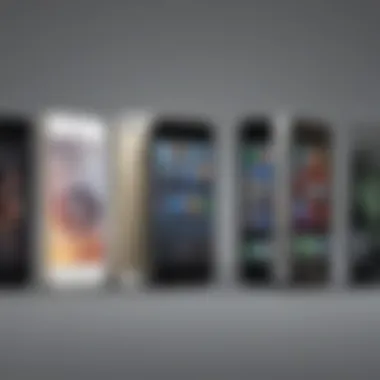Tracing iPhone Generations: Features and Innovations


Intro
The Apple iPhone represents a pinnacle of advancement in mobile technology since its introduction. This device has evolved remarkably since the release of the original iPhone in 2007. Each generation brought forth new features, improvements, and enhancements that shaped not just Apple’s legacy, but also redefined standards across the smartphone industry. The following sections will navigate through the various generations of iPhones, illustrating their unique attributes and the technological advancements each one contributed.
Product Overview
The iPhone series has undergone extensive transformation over the years. Each new iteration integrates significant upgrades and features, reinforcing Apple's commitment to innovation. An example is the iPhone 12, showcasing a blend of design refinement and enhanced performance.
Key Features and Specifications of iPhone
- Display: 6.1-inch Super Retina XDR display
- Processor: A14 Bionic chip
- Camera: Dual 12 MP camera system
- Operating System: iOS 14
Available Variants/Colors of the Product
The iPhone 12 is offered in several colors such as Black, White, Product(RED), Green, and Blue. It comes in two storage options: 64GB and 128GB, with some variations available in 256GB.
Design and Build Quality
The design language of the iPhone 12 reflects a modern aesthetic. With flat edges and a ceramic shield front cover, it offers improved durability compared to previous models.
Visual Description of the Device's Design
The sleek and minimalist design is both attractive and functional. Available in an aluminum frame, the device feels premium in hand.
Materials Used in the Construction
The body is constructed from aerospace-grade aluminum and glass, making it resilient yet lightweight. The increased protection against cracks and scratches enhances its appeal.
Ergonomics and Overall Build Quality Assessment
In terms of ergonomics, the iPhone 12 is pleasant to hold and use. Its lightweight design helps in prolonged usage without discomfort.
Performance and User Experience
Performance is a cornerstone of the iPhone experience. The iPhone 12, equipped with the A14 Bionic chip, excels in various tasks.
Processor Details and Performance Benchmarks
The A14 Bionic chip provides blazing fast speed, with benchmarks showcasing superior performance in processing tasks and applications.
User Interface and Operating System Features
Running on iOS 14, the device features enhancements in widgets and application organization, elevating user engagement.
Multitasking Capabilities and Overall User Experience
Users can seamlessly switch between apps and utilize the powerful hardware for complex tasks, exemplifying Apple’s focus on seamless user experience.
Camera and Media Capabilities
The iPhone 12 boasts a remarkable camera system, enhancing photography and video recording experience.


Camera Specifications and Sample Images
The dual 12 MP cameras allow for stunning images, even in low-light conditions. Night mode is a significant feature, capturing detail in darkness.
Video Recording Capabilities and Supported Formats
It supports Dolby Vision HDR recording, providing filmmakers extensive creative control and high-quality output.
Audio Quality and Media Consumption Experience
Media playback is excellent, with spatial audio capabilities delivering an immersive experience.
Pricing and Availability
The pricing structure of the iPhone 12 reflects its high-end positioning in the market.
Pricing Options for Different Variants
- 64GB: $799
- 128GB: $849
- 256GB: $949
Availability in Various Regions/Markets
The iPhone 12 is available in multiple markets, including the US, Europe, and parts of Asia, making it accessible to a broad audience.
Comparison with Competitor Products in Terms of Value for Money
In comparing the iPhone 12 with competitors like Samsung Galaxy S21, users may find that despite a similar price range, the iPhone 12 offers unique features and a cohesive ecosystem that enhances overall value.
The evolution of the iPhone is a testament to Apple's relentless pursuit of excellence in the competitive technology landscape.
Preamble to iPhone Generations
The introduction of iPhone generations encompasses the chronological development of Apple's flagship smartphone, offering a deep dive into the technological advancements that have marked each iteration. Understanding these generational shifts is crucial not only for Apple enthusiasts but also for tech lovers who appreciate the context of mobile innovation. Each generation reflects significant changes, providing insight into the evolution of mobile technology itself.
The importance of this overview lies in its ability to highlight specific features, benefits, and technological considerations inherent in each version of the iPhone. This knowledge not only informs potential buyers but also enriches their understanding of the iPhone's role in modern digital life.
Moreover, analyzing the different iPhone generations offers a perspective on how changing consumer demands and technological advancements have influenced design and functionality over the years. Sustaining a conversation about the iPhone generations remains integral to appreciating where mobile technology is headed.
The Evolution of Mobile Technology
The evolution of mobile technology has progressed dramatically since the launch of the first iPhone in 2007. At its inception, the mobile landscape was dominated by feature phones. The arrival of the iPhone changed not only Apple's trajectory but also that of the entire industry. It introduced the concept of a multi-touch interface, which became a standard feature for smartphones. As mobile technology evolved, iPhones kept pace, redefining features such as wireless communication, app ecosystems, and internet connectivity.
Each successive iPhone generation incorporated enhancements that aligned with advancements in mobile technology. From improved processing power to enhanced camera capabilities, these developments are significant markers in the timeline of mobile phone evolution. For example, the introduction of 4G LTE changed data speeds and capabilities dramatically, enabling more robust applications and services.
Significance of the iPhone in Modern Society
The significance of the iPhone in modern society cannot be overstated. It serves as a primary communication tool and a central device for accessing information, pure entertainment, and various services. The iPhone’s impact goes beyond personal usage; it has transformed industries, influencing how businesses operate by enabling mobility and efficiency.
With the development of countless applications, the iPhone has encouraged creativity and innovation among developers. The App Store has become a platform where various functionalities can connect users to virtually endless opportunities. As a result, the iPhone has positioned itself as an essential tool in both personal and professional domains, shaping modern communication, business practices, and social interactions.
"The iPhone represents more than just a device; it is a conduit through which the modern world connects, operates, and progresses."
Overview of iPhone Generations


The iPhone has truly transformed the smartphone landscape since its inception. Examining the different generations of iPhones allows us to understand how Apple has continuously adapted to technological advancements and changing consumer needs. Each iPhone model not only reflects a certain period in mobile technology but also showcases Apple's unique approach to design and functionality. This examination is critical for appreciating the series's overall trajectory.
The evolution of iPhones highlights the company's response to competitive pressures, internal visions, and global shifts in mobile communication. Understanding these generational shifts equips Apple enthusiasts and potential consumers with knowledge about what each model uniquely offers. Key features, innovations, and enhancements define specific generations, keeping the lineup fresh and appealing.
The discussion of iPhone generations encompasses a range of elements:
- Technological Innovations: Each generation introduces significant developments, including processors, camera systems, and display technologies.
- Consumer Evolution: Understanding how user interactions and requirements have driven design changes provides insight into Apple's market strategies.
- Cultural Impact: The iPhone's influence extends beyond technology, shaping social interactions and personal habits in daily life.
This section will walk through the first iPhone to the latest model, revealing how each version charts new territory in an ever-evolving technological landscape.
Technological Advancements Through Generations
The progression of iPhone generations is marked by significant technological advancements. These improvements not only enhance users’ experience but also set benchmarks within the mobile industry. Each generation of iPhone introduces new capabilities and refinements that resonate across the tech landscape. These advancements are not just incremental upgrades; they shape how consumers interact with mobile devices. Understanding these improvements is crucial for appreciating the evolution of Apple's flagship smartphone. It highlights how each change influences device performance and user satisfaction.
Processor Improvements
Every new generation of iPhone arrives with upgrades in processor technology. The A series chips, recognized for their efficiency and power, have progressively transformed the performance capabilities of the device. Starting with the original iPhone, which utilized a simple ARM processor, Apple has developed a series of advanced chips. The A14 Bionic chip in the iPhone 12 features a 6-core CPU and 4-core GPU, leading to incredible computational speed and graphics performance. These processor enhancements improve not just everyday tasks like app usage but also intensive activities like gaming and video editing.
Camera Enhancements
Camera technology has seen dramatic evolution across iPhone generations. Starting from a 2-megapixel camera on the first iPhone, the model range now includes advanced multi-lens systems that capture professional-grade images. For example, the iPhone 13 Pro boasts a triple-camera system with features like Night mode, Deep Fusion, and ProRAW. These advancements cater to both casual users and professional photographers, emphasizing the importance of the camera in the overall smartphone experience. Enhanced image processing also allows for improved low-light performance and faster autofocus.
Battery Life Developments
Battery technology has not kept pace with other advancements, yet significant improvements have been made over the years. Each new iPhone generation brings enhancements in battery efficiency, primarily achieved through better processors and software optimizations. The iPhone 13, for instance, offers up to 15 hours of video playback. This is a direct result of both the A15 chip's efficiency and power management features. These developments mean users can rely on their devices for longer durations without compromising performance. Extended battery life addresses a common concern, enhancing user convenience and satisfaction.
Display Innovations
The display technology has also significantly advanced through the generations. The transition from a simple LCD display to the latest Super Retina XDR displays marks a considerable milestone. The iPhone X introduced the first OLED screen, offering deeper blacks and vibrant colors. Subsequent models continued to improve screen resolution and brightness. The iPhone 13's display increases brightness capabilities to up to 800 nits, enhancing usability in various environments. These innovations make visual media, app usage, and gaming more immersive, shaping how users view content on mobile devices.
"Understanding these advancements is key not just for traditional consumers but also for enthusiasts wanting to grasp Apple's ongoing innovations."
Through these technological advancements, Apple has consistently elevated the user experience of the iPhone. Each iteration not only rides on the successes of its predecessors but also sets new standards for what a smartphone can offer.
iPhone Generations in the Market Context
The iPhone has maintained a significant presence in the mobile market since its introduction. Understanding the various generations of iPhones and their market context gives insight into how Apple has shaped consumer expectations and industry standards over the years. Each generation is not merely a technological advancement; it signifies shifts in market dynamics and consumer preferences. Over the years, Apple has crafted its brand image, and each iteration of the iPhone contributes to this narrative. By examining the reception of each model, we can uncover trends and patterns in consumer behavior, as well as the impact of Apple on overall market competitiveness.
Market Reception and Consumer Feedback
The reception of each iPhone generation reveals the changing expectations of consumers. Initially, the iPhone was celebrated for its user-friendly interface and groundbreaking design. As new generations were released, feedback highlighted both advancements and emerging issues. For instance, the iPhone 4’s Retina display received widespread acclaim. However, other features faced criticism regarding durability. Each model's success relied heavily on how well it resonated with users.
- Some of the key points of consumer feedback include:
- Design: Apple frequently updates the aesthetics of their devices. The iPhone 5’s sleek aluminum body contrasted with previous models, appealing to users who valued premium materials.
- Performance: Significant advancements in processing power with the introduction of A-series chips have consistently impressed consumers, attributing smooth operation to the iPhone experience.
- Camera Quality: With each generation, advancements in camera technology impact consumer choice. The iPhone 12 series, for example, was praised for its night mode and computational photography capabilities.
The importance of understanding market reception lies in the part it plays in shaping future generations. The response from users informs Apple's strategies, allowing for targeted improvements in subsequent releases.
Impact on Competitors
The launch of new iPhone generations has consistently put pressure on competitors to innovate. Each release sets a benchmark not only for performance but also for consumer expectations in design and features. When Apple introduced the iPhone X with Face ID, competitors rushed to incorporate similar technology into their devices.


- Competitive Dynamics:
- Features: Companies like Samsung and Google quickly adapted their offerings, ensuring camera quality, battery life, and software integration matched or exceeded the latest iPhone.
- Marketing Strategies: Apple’s marketing campaigns create a huge buzz, often forcing rival brands to adjust their strategies to maintain relevance in consumers' minds.
- Pricing Models: The shift in pricing seen with models like the iPhone 14 reflects broader industry trends that competitors had to respond to, changing how devices are positioned in the market.
The influence of Apple within the smartphone market emphasizes its role as a leader and innovator, continuously motivating others to keep pace.
Overall, analyzing how iPhone generations are received and their effects on competitors highlights Apple’s pivotal role in the mobile technology landscape. It also underscores the necessity for brands to anticipate market shifts and adapt accordingly.
The Future of iPhone Generations
The future of iPhone generations is a critical focal point in understanding the trajectory of Apple's dominance in the smartphone market. As technology continues to evolve rapidly, the expectations for each new iPhone model grow correspondingly. Analyzing future trends in design, functionality, and user experience can provide insights that are beneficial for consumers and enthusiasts alike.
Anticipation around new releases can influence market dynamics, impacting both consumer behavior and competitor strategies. This section aims to clarify emerging trends and their significance. Understanding how upcoming iPhone models can address current challenges, such as battery efficiency, display technology, and integration with other devices, is essential for those following Apple's journey.
Speculations about Upcoming Releases
As Apple prepares for future iPhone launches, several speculations arise. Rumors often circulate about potential features, such as foldable displays and enhanced augmented reality capabilities. The recent advances in AI have led to expectations that future iPhones may incorporate sophisticated machine learning algorithms to improve user interaction.
Another area of interest is the anticipated shift towards 5G technology. Although earlier models incorporated this feature, subsequent generations may enhance its capabilities. Users expect a smoother experience with lower latency and improved connectivity. The move towards this technology reinforces Apple's commitment to keeping pace with industry standards.
- Enhanced Display: Speculating about developments in display technology, previous iPhones have utilized OLED screens. Future generations might explore microLED or even flexible display technologies.
- Camera Innovations: Continuous improvements in camera technology remain a priority. Future iPhones might adopt even larger sensors and advanced computational photography techniques.
- Battery Capacity: There is an ongoing emphasis on battery life. Future iterations could utilize new materials or technology that extends battery longevity and charging efficiency.
The future innovations in iPhones are intricately linked to user needs. Consumers expect devices that not only meet their daily requirements but also anticipate their future demands.
Sustainability in Manufacturing
Sustainability is becoming increasingly vital in manufacturing processes, particularly for tech companies like Apple. The future of iPhones does not merely encompass technological advancements but also the ethical considerations surrounding their production. Consumers are more aware of the environmental impact of electronic devices, prompting brands to take active steps toward sustainable practices.
Apple has committed to a more responsible manufacturing process. Future generations of iPhones may user recycled materials and aim toward improving energy efficiency in their production. Apple aims to use 100% recycled aluminum in its devices. This move reflects a significant shift towards minimizing the carbon footprint associated with their products.
Furthermore, the potential integration of renewable energy sources in manufacturing sites could enhance Apple's sustainability efforts. Ensuring that energy used in the production of iPhones comes from clean sources may become an industry standard.
As technology advances, the balance between innovation and environmental stewardship will likely shape the design and manufacturing of future iPhones. Engaging with sustainability reflects societal values and can influence purchasing decisions, thereby affecting the overall market.
Overall, the future of iPhone generations will be characterized not only by advancements in technology but also by significant strides towards sustainability in manufacturing, making it a pertinent issue for both consumers and industry stakeholders to consider.
Culmination
The conclusion acts as a vital summary within this article, encapsulating the journey through the various generations of iPhones. It serves not only to recapitulate the innovations presented but also to reflect on their significance in the broader context of mobile technology. Understanding the impact of each generation helps readers appreciate the evolution of Apple's flagship device, as well as its significance in modern society.
Recapitulation of Innovations
Each generation of iPhone has introduced pivotal technological advancements that reshaped user interaction and enhanced functionality. For instance, the first iPhone overshadowed previous smartphones by integrating a touch screen and introducing the App Store. Each subsequent model continued this trend, making incremental yet impactful changes. The iPhone 4 and 4S introduced the Retina display, which set new standards for visual performance.
- Key Innovations:
- Processor Improvements: From the original iPhone processor to the A9 chip in the 6S, performance has exponentially increased.
- Camera Enhancements: The camera has evolved from a basic 2MP to a sophisticated multi-lens system capable of low-light photography and portrait modes.
- Battery Life Developments: Each model optimized battery performance, providing users with longer usage times and enhanced energy efficiency.
- Display Innovations: Transitioning from LCD to OLED displays has greatly improved clarity and color.
These innovations not only define each generation but also set benchmarks within the tech industry.
Final Thoughts on iPhone Legacy
The legacy of the iPhone is characterized by its transformative effect on both consumers and competitors. Apple constantly redefines mobility, pushing boundaries that other manufacturers strive to match. The iPhone's influence on social interaction, business, and personal experiences is undeniable.
- Lasting Impact:
- The iPhone has changed how we communicate, share content, and access information.
- It has created an ecosystem of applications and services, driving economic change and innovation.
In closing, the iPhone generation narrative is not simply about hardware revisions but about an ongoing dialogue between technology and human interaction. This dialogue continues to evolve, promising future advancements as Apple shapes the tech landscape.















